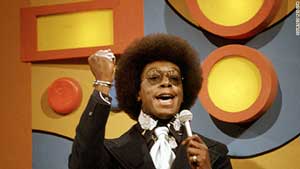DON CORNELIUS
His ‘Soul Train’ instilled Black pride
By
Monica Moorehead
Published Feb 9, 2012 8:42 PM
As a teenager living in Hampton, Va., I would eagerly look forward to watching the TV show “Soul Train” every Saturday morning like millions of others in the U.S., the majority of them Black people like me. “Soul Train” was the place to see the most popular Black artists, like the O’Jays, LaBelle, Al Green, Chaka Khan, the Jackson Five and many more, perform along with the incomparable Soul Train dancers. And at the end of each show, the creator of “Soul Train,” Don Cornelius, would tell the viewers in his rich, very cool baritone voice, “I wish you love, peace and soul.”
It is because “Soul Train” touched and enriched the lives of Black America, even today, that music lovers everywhere were stunned and saddened to hear that Cornelius had reportedly committed suicide, with a self-inflicted gunshot wound to the head, on Feb. 1 at his home in Los Angeles. He was 75 years old. Thousands upon thousands of twitter messages flooded the Internet paying tribute to him. Flash mobs everywhere are paying homage to him.
Cornelius was the host of “Soul Train” from 1971 until 1993. When the show ended in 2006, it was the longest-running syndicated television show in U.S. history. This is a profound achievement considering the fact that “Soul Train” was not only created but owned outright by Cornelius, an African American.
The roots of “Soul Train”
“Soul Train” was a by-product of the struggle against racism. Following the passing of the 1964 and 1965 federal Civil Rights bills, which focused on legally breaking down racial barriers in the Jim Crow South, Dr. Martin Luther King decided to target the white-only, segregated neighborhoods in Chicago. Cicero, a Chicago suburb, was a hotbed of pro-Nazi activity. Dr. King, who was physically assaulted during a march in Cicero, once stated that racism in the North was in some ways more vicious than that in the South. Police brutality along with abject poverty was rampant, especially in African-American urban cities like Chicago.
Cornelius grew up on the South Side of Chicago. He became a news reporter for a local station, WCIU, and was once assigned to interview Dr. King. In response to the negative, racist images Black people were relegated to in the white-dominated corporate media, Cornelius stated, “I had a burning desire to see Black people presented on television in a positive light.”
Cornelius convinced WCIU to allow him to develop a local show named “Soul Train” to help showcase well-known, local African-American soul and blues singers such as Curtis Mayfield, the Staple Singers and B.B. King. The Philadelphia-based O’Jays also appeared on the first show, which aired on Aug. 17, 1970. Local Chicago Black youth became dancers on the show.
“Soul Train” had become so popular by the end of its first year that Cornelius moved the show to Los Angeles, around the same time that Motown moved there from Detroit. On Aug. 2, 1971, “Soul Train” began its national syndicated run, initially attracting seven cities. In 1972, due to the appearances of popular artists like Marvin Gaye and Aretha Franklin, as well as the Los Angeles dancers and Cornelius’ charisma, “Soul Train” expanded its syndication to 50 cities.
The show was gaining so much unprecedented popularity that “American Bandstand,” a popular dance show dominated by white singers and dancers, was losing a huge chunk of its white audience to it. AB’s creator, Dick Clark, financed an offshoot show, “Soul Unlimited,” in an attempt to undermine “Soul Train.” Many Black performers along with Cornelius denounced this obvious ploy, forcing Clark to take “Soul Unlimited” off the air.
By 1973, “Soul Train” was syndicated in 70 cities and had an estimated 4 million viewers. Not only did “Soul Train” fill a huge void in helping to break Black rhythm and blues performers into mainstream culture, but it also showcased products, like Afro-Sheen for natural hair, geared towards promoting pride in the Black community.
In 1974 — a period when Black schoolchildren were attacked while being bussed to predominately white schools as in South Boston — “Soul Train” introduced a segment called the Scramble Board, in which participants spelled out the names of prominent Black people from all walks of life.
But by far the most enduring feature of “Soul Train” was the Soul Train line, where dancers would show off the moves — many created by the show — of the various music eras, like popping, ticking, break dancing, the robot and the moonwalk. Michael Jackson made the moonwalk famous worldwide, but he gave credit to the Soul Train dancers for introducing it to him and to the world. Many famous artists, like Rosie Perez and Snoop Dogg, attribute “Soul Train” to enhancing or jump starting their careers.
“Soul Train” was certainly an outgrowth of an important time of anti-racist struggle. It is to Don Cornelius’ credit that he fought to make an important social contribution to this period in the form of “Soul Train.” There will never, ever be another phenomenon like it.
Background material, including quotes in this article, are from a 2010 VH1 documentary, “Soul Train:
The Hippest Trip in America.”
Articles copyright 1995-2012 Workers World.
Verbatim copying and distribution of this entire article is permitted in any medium without royalty provided this notice is preserved.
Workers World, 55 W. 17 St., NY, NY 10011
Email:
[email protected]
Subscribe
[email protected]
Support independent news
DONATE


